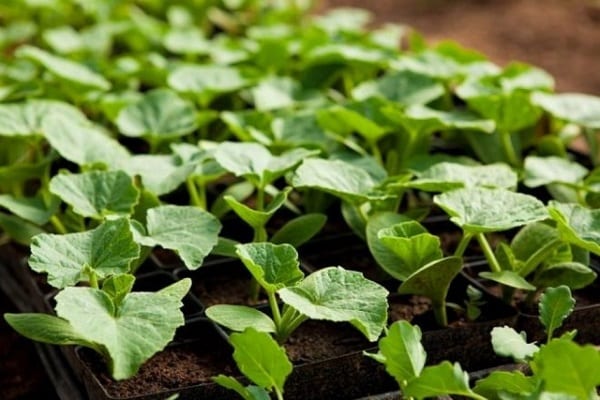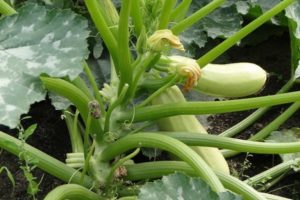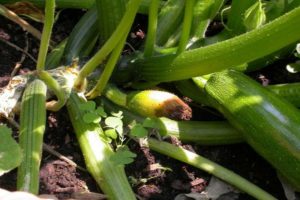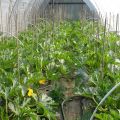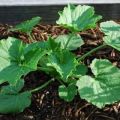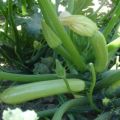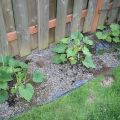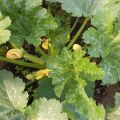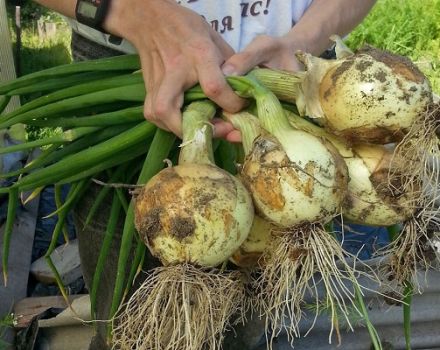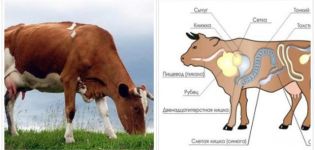Why zucchini leaves turn yellow in open ground: what to do
Vegetable growers often encounter such a phenomenon as yellowness and shedding of zucchini leaves. Biological scientists give advice on how to combat and eliminate this problem. But in order to know which method to use, it is necessary to establish the reason why the leaves of zucchini turn yellow in the open field.
Greens on a vegetable crop are always an indicator of its health. So, if the leaves on the zucchini curl, darken, turn yellow or completely fall off, the plant signals that it needs urgent help.
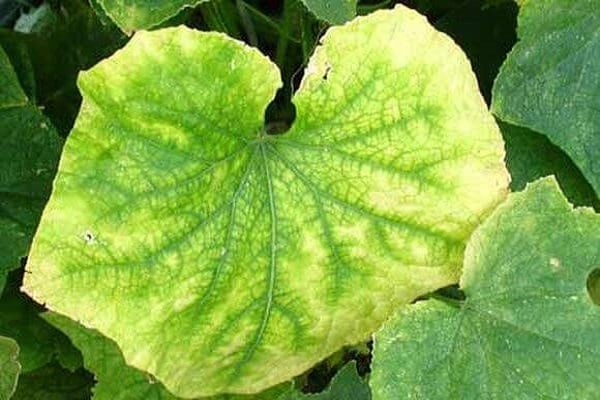
Improper watering of garden culture
One of the important steps in growing any garden crop is watering. When performing the procedure, a number of rules should be observed:
- For irrigation it is necessary to use only settled water.
- Irrigation should be done in the morning or evening. It is important not to let water get on the greens. If this happens, the sun's rays burn the leaves, as a result, they curl and fall off in the zucchini.
- Leaves often dry out due to lack of moisture in the soil. Watering should be timely and regular. The amount of irrigation must be determined by the condition of the soil. It is important to avoid cracks on the ground surface. This damages the horse system of the bush. Stagnation of moisture in the soil is also harmful. Excessive dampness leads to the fact that the leaves become covered with yellow spots and dry out.
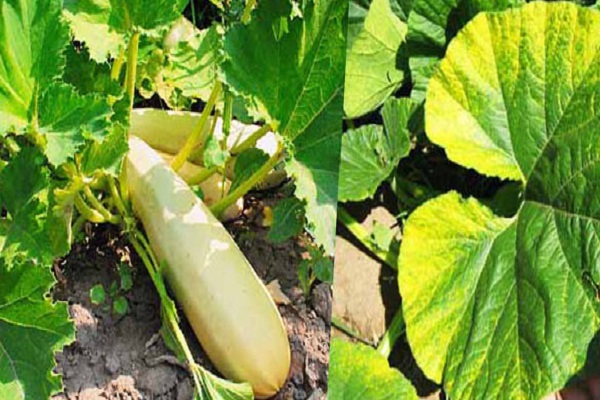
The condition of the plant depends on watering and weeding, when watering, you should try not to fall on the inflorescences and do not flood the bushes with water from above. This is one of the most important conditions for growing squash... It is necessary to weed the beds in a timely manner, not allowing the grass to deplete the soil in the garden. Gardeners mulch the holes with sawdust or dry straw. The procedure allows you to keep the soil in proper condition and prevent cracking of the soil.
Zucchini seedlings turn yellow
Growing marrow seedlings is important. Young shoots are sensitive and can be easily damaged due to improper care or lack of useful minerals in the soil.
The main reasons why the tops on the seedlings wither or turn yellow:

- If yellow leaves appear, the reason may lie in a lack of nitrogen in the soil. This factor can be determined by the specific distortion of the foliage forms. The leaf turns yellow first along the edges, then it deforms and falls off. The situation can be corrected by applying nitrogen fertilizers to the soil. Funds are purchased in specialized stores. For seedlings, it is best to use water-soluble preparations. A solution is prepared from them and the shoots are watered.
- Often, in a young plant, leaves turn yellow prematurely and fall off due to a lack of nutrients in the soil. You can buy the nutrient soil at the store or prepare it yourself. To do this, you need to take peat, coarse river sand and sod land. All ingredients are taken in equal parts and mixed well. It is recommended to periodically feed seedlings with complex mineral fertilizers. This will allow young sprouts to form a correct root system and strengthen immunity to various fungi.
- Gardeners water the seedlings from a spray bottle or through a sieve. The main thing is to direct the water to the ground, and not to the foliage. Remaining moisture on the leaves can lead to the appearance of various fungi or pests.
Tender and young seedlings need special, gentle care. Therefore, it is important at this stage of agricultural technology to strictly adhere to the rules and requirements for plant care.
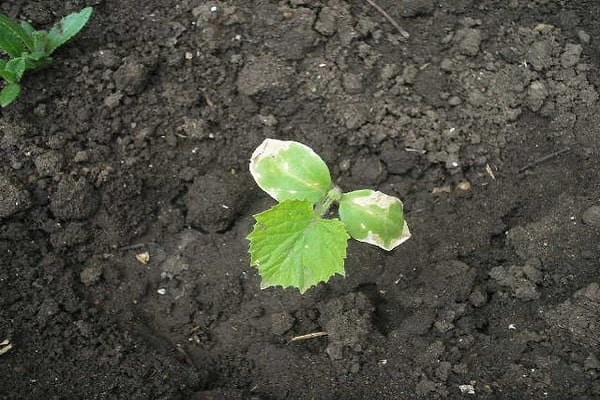
Why do zucchini fruits turn yellow?
Often, gardeners are faced with such a problem when already ripe vegetables have turned yellow. There can be several factors contributing to the problem.
The most common cause of this phenomenon is excess moisture in the soil. It is worthwhile to properly water and monitor the condition of the soil. Large fruits, due to their heavy weight, can lie on the ground. Being constantly in dampness, they are affected by various fungi, as a result, the fruits turn yellow and deteriorate. It is important not to overmoisten the soil. If this happens, you can correct the situation by adding dry sawdust, sand or freshly cut grass to the hole.

Depleted soil cannot provide the necessary nutrients to the bushes. The plant, having exhausted all its forces at the stage of fruit ripening, begins to die. The first sign may be wilting and darkening of the fruit. To prevent this from happening, the beds need to be well fertilized before planting. Zucchini perfectly perceive organic matter, therefore humus or manure is introduced into the soil.
Sometimes the cause of the yellowness of the zucchini may be late harvesting. If the fruits are overexposed on the plant, then over time their peel will change color from light green to milky yellow. Such zucchini lose their juiciness. Their rind becomes rough and tough, and the seeds increase in size. You need to harvest on time in order to preserve its taste.
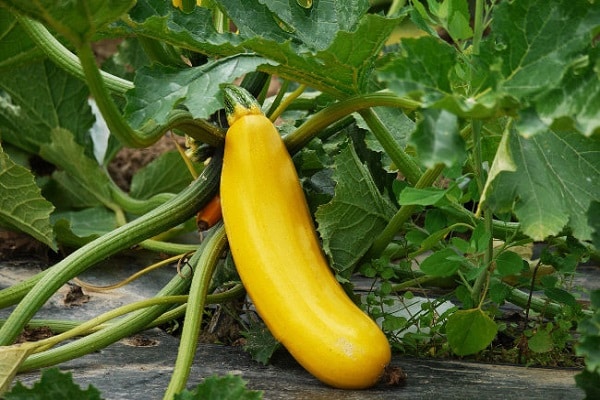
Damage to leaves with downy mildew
Fungi and viruses that attack the plant can damage the greenery on the bushes. A common cause leading to this phenomenon is infection of zucchini with powdery mildew. In order to detect this fungus in time, you need to find out its main signs.
A characteristic manifestation of the disease is the presence of yellow plaque on the stems and the inner side of the leaves. The infection quickly spreads through the beds and leads to the defeat of the bushes.
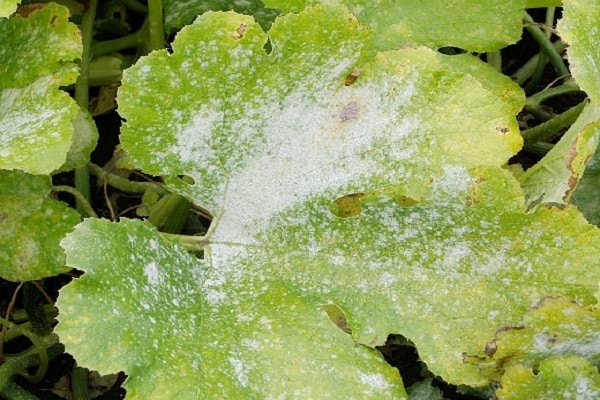
When small specks and yellow spots appear on the leaves of the zucchini, an urgent need to treat the affected plant. Damaged greens are removed along with the branches. If the fungus has spread to the entire bush, then it is better to completely remove it from the garden. In the fight against downy mildew, Bordeaux mixture is used. Experienced gardeners recommend spraying with copper oxychloride.
The fungus occurs due to stagnation of moisture and dampness in the soil. Often the infection spreads during prolonged rainy weather. To avoid infection, gardeners feed vegetables in the beds, feed the squash, if the leaves are already turning yellow, it is also desirable. To do this, you need to use nitrogen and potash fertilizers. Copper, iron and phosphorus strengthens plant immunity well.
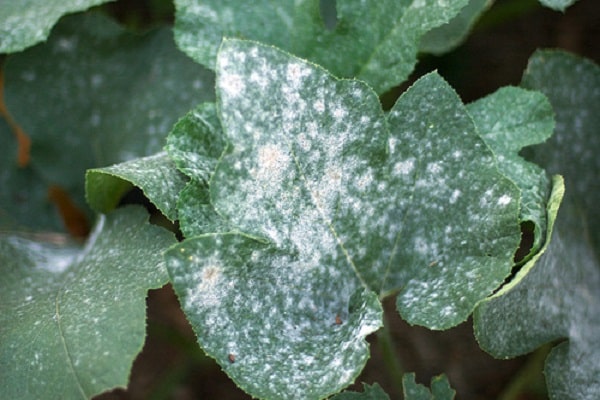
It is better to say goodbye to leaves that have turned yellow from various viruses or fungi. They are removed from the bushes and burned. It is unacceptable to use contaminated greens for compost. You cannot leave it on the site.
Plants must be processed immediately after cleaning the bushes. The solution is prepared just before use. Spraying is carried out in the morning, calm weather. If you do not carry out preventive treatments, diseases begin to develop: powdery mildew, downy mildew or chlorosis.
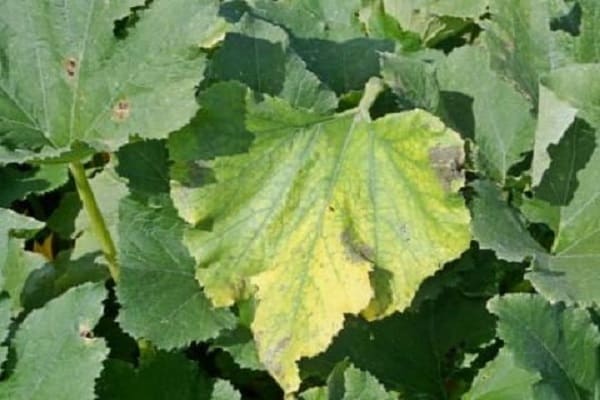
Appears powdery mildew in zucchini often, seedlings are the first to suffer. Weak sprouts cannot resist various infections. Therefore, young plants are kept in a separate room.
If they grow in the same greenhouse with adult bushes, then you need to process all the plants at the same time. Copper sulfate is well suited for both preventive measures and for combating fungus.
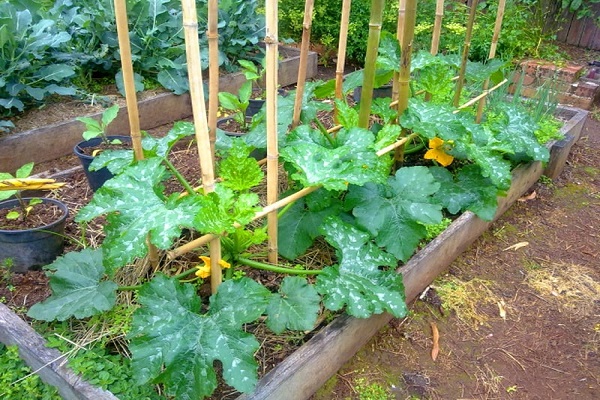
Why are zucchini bitter?
The vegetable has excellent taste. It has enough sweetness, spice and juiciness. Ripe zucchini has a characteristic aroma. It vaguely resembles the smell of melon, cucumber or watermelon.
It also happens that the taste of the fruit can deteriorate, in particular, bitterness appears. It is worth immediately tackling this problem, recommendations for leaving are the main tools in correcting the situation.
Improper watering affects the distortion of the taste of the fruit. Lack of moisture in the soil and prolonged drought lead to the appearance of a bitter taste in zucchini. You need to water the beds regularly, but at the same time make sure that the water does not stagnate in the holes.
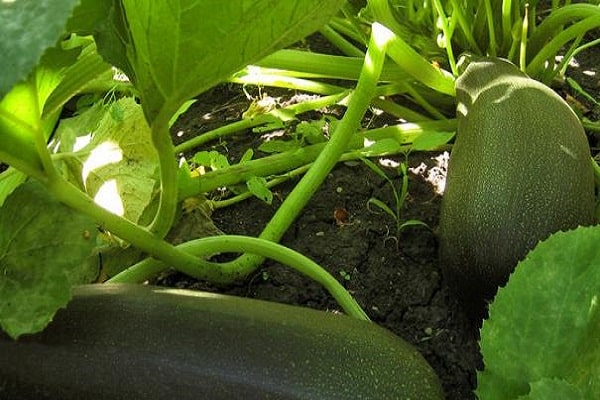
The lack of nutrients as a result can lead to the fact that the palatability of the fruit will deteriorate. The vegetable crop needs regular fertilization with nitrogen preparations and complex products intended for melon, watermelon and cucumbers.
When growing a popular vegetable, it is important to properly care for the plant. Proper watering and feeding have a great impact on the taste and quality of the future harvest.
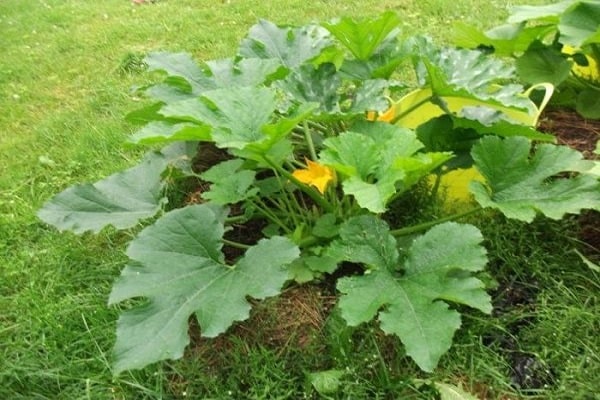
Methods of dealing with yellowness
It is important to initially determine the root cause of the problem and only then select the appropriate way to deal with it.
The appearance of yellowness in the seedling stage can be caused by a lack of sunlight or poor soil. An experienced gardener effectively fights this stage; this must be dealt with by eliminating the factors leading to the problem: the seedlings are removed from a dark place, but do not allow direct sunlight to enter. The soil is fed with mineral fertilizers once a week. Before planting seedlings on the beds, the soil is well fertilized with organic matter, so humus must be added to the hole.

You can also use folk remedies: spraying young seedlings with milk and iodine prevents yellowness.
The plant needs feeding at any stage of its growth. Zucchini respond well to nitrogen, copper, potassium and phosphorus.
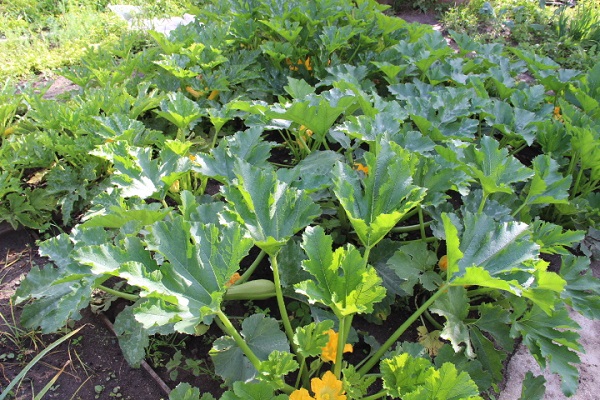
Preventive measures
It is best to avoid the appearance of yellowness and dryness of greenery. Preventive measures will help prevent this phenomenon.
Nutrient soil and fertilizers have different effects on the growth of vegetable crops. It is necessary to correctly select mineral fertilizers. It is best to immediately purchase a complex preparation that is well suited for both seedlings and adult bushes.
Top dressing of shoots should be carried out at least 1 time per week. At the stage of active growth and formation of the root system, it is best to use nitrogen and potassium preparations.
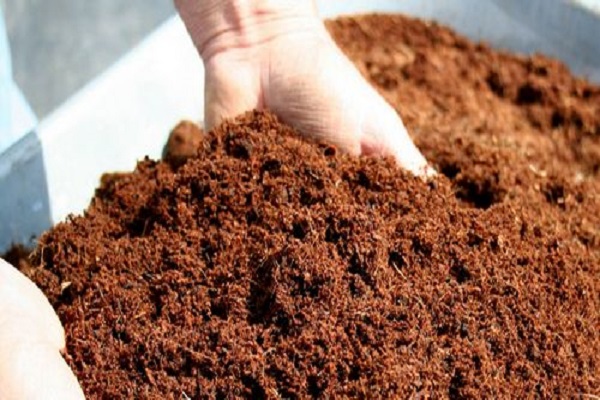
Tips from a seasoned gardener
Experienced gardeners give the following tips for growing zucchini:
- It is important to water the plant on time.
- Do not use cold water for irrigation.
- The ground is prepared before planting. To do this, manure is applied to the garden in the soil, organic fertilizers have a beneficial effect on the quality of the fruits.
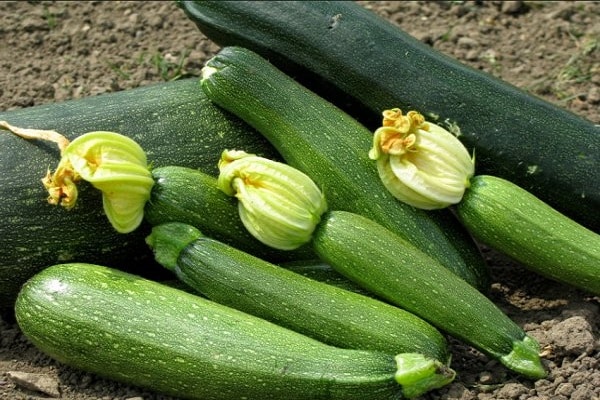
The squash culture is tender and requires proper farming techniques. If you do everything competently and professionally, you can collect a fairly rich harvest. One bush of zucchini gives more than 10 kg of fruit over the summer.
Common causes of leaf damage on zucchini are improper care, depleted soil in the beds, the appearance of fungi or harmful insects, and improper fertilization with minerals. In order to remedy this situation, it is recommended to establish the root cause. The plant will cease to suffer and its leaves will turn yellow.
